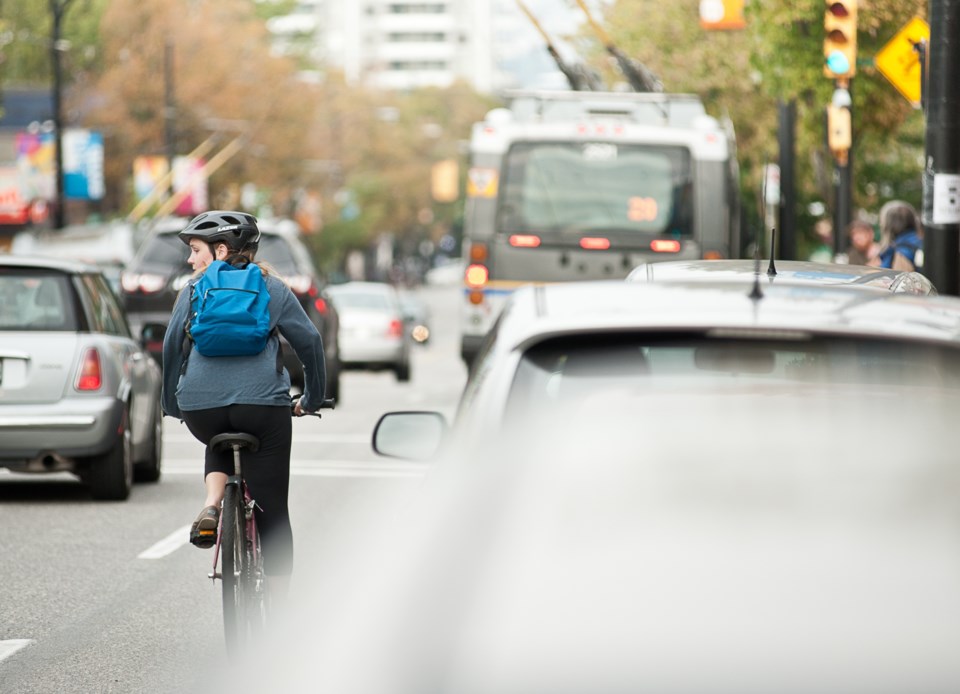Despite the addition of a new cycling greenway through the West End, cyclists are still riling pedestrians by riding on sidewalks and ignoring traffic signals.
John Bacon owns a dog-walking business in the West End and says he can’t even count the number of times he’s almost been hit by cyclists flying down the sidewalk.
“Often I’m walking with four dogs at a time, and when a cyclist comes [riding down the sidewalk], it startles the dogs,” he says. “I have to pull them out of the way, and sometimes they try to bolt.”
Bacon has witnessed cyclists running red lights, running stop signs, riding through crosswalks, and generally wreaking havoc in the neighbourhood. Even on the new Comox-Helmcken Greenway bike route, which opened last year, Bacon says he routinely sees cyclists riding on the sidewalks.
Despite complaints to the police and to City Hall, Bacon says he sees little being done about what he considers to be a serious public safety threat.
This past July, a 43-year-old American tourist broke her back after being struck by a speeding cyclist along the seawall. In May 2013, a cyclist died after falling into traffic following a collision with a pedestrian on the sidewalk of the Stanley Park Causeway.
Last year, West End MLA Spencer Chandra Herbert called on the Vancouver Police Department to crackdown on cyclists who flout the law.
“As a cyclist, while I don’t agree with it, I can understand why some choose to ride on sidewalks. Roads are sometimes dangerous, and mostly not designed with cyclists in mind. I’m glad improvements for cyclist safety are underway across Vancouver,” Herbert said in an open letter to VPD chief Jim Chu. “That being said I don’t think making sidewalks unsafe for pedestrians is acceptable. Sidewalk cycling remains a real issue in this community that merits action.”
City of Vancouver Director of Transportation Jerry Dobrovolny said the City is working with the VPD who enforce the BC Motor Vehicle Act and bylaws that apply to cyclists.
“As more cyclists take to the streets, everyone – cyclists and motorists – has to learn to share the road. Cyclists have the same rights and responsibilities as drivers,” he said.
The City is currently eyeing a goal of achieving zero traffic-related fatalities, and has commissioned a comprehensive study of cycling safety issues, to be released in the new year. This follows a similar Pedestrian Safety Study which was completed in 2012. Meanwhile, Vancouver Police have recently resorted to setting up radar traps along the seawall to get cyclists to slow down.
However, enforcement is just one part of the solution, Dobrovolny notes. Education and engineering are the other two components that contribute to safe cycling.
The City of Vancouver’s ongoing campaign to create protected bike lanes will allow cyclists to feel comfortable on the streets, and hopefully get them off the sidewalks.
That position is supported by Vancouver cycling advocacy group, HUB.
“Anyone who disregards traffic by-laws and road rules puts themselves and others at risk, and generally this is not restricted to cycling – it happens with people walking and driving vehicles too,” said Colin Stein, HUB’s director of communications. “We’re hearing more about the issues…and this is likely due to the relatively high growth of cycling as a mode of everyday transportation.”
According to the City of Vancouver, the number of cycling trips in the city grew 41 per cent between 2008 and 2011.
“In the West End specifically, we’ve heard about sidewalk riding, and it’s mainly a symptom of the lack of designated space for cycling, combined with high pedestrian traffic in a dense area,” Stein said.
Better education for cyclists is another way to help curb the problem.
HUB offers “Bike Ed” courses that cover aspects of the Motor Vehicle Act and various city bylaws, and emphasize staying off the sidewalks except where signed as a shared path or in those municipalities that allow sidewalk cycling. But lawful behaviour and confidence on the roads go hand-in-hand, he notes.
“The fact that cyclists have the same responsibilities as drivers in terms of road use doesn’t necessarily mean they’ll feel comfortable doing so,” he says. “In that respect, expanded infrastructure to separate bikes from pedestrians and motor vehicles is needed, or at minimum demarcation of where bikes can be positioned on the road for optimum visibility and safety.”
However, Bacon says if cyclists aren’t comfortable riding in the streets, they should walk their bike on the sidewalk, or take the bus.
“I don’t have a problem with bike lanes, I’m glad they are putting in the infrastructure for cyclists, we need that,” he said. “But there also needs to be enforcement. The cyclists need to use those lanes and follow the rules of the road.
“Cyclists have a right to the streets and a right to safety, but pedestrians have rights too, and we shouldn’t have to dive out of the way of vehicles on the sidewalk.”



